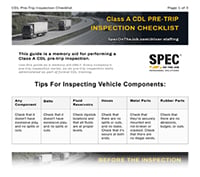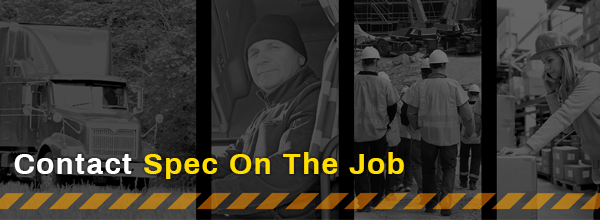
Download the CDL Pre-Trip Inspection Checklist (PDF)
A CDL pre-trip inspection is a crucial part of safely operating a commercial vehicle. It’s also required by the Federal Motor Carrier Safety Administration.
Use this guide as a memory aid ONLY. Every company’s pre-trip inspection varies, as do pre-trip inspection tests administered as part of formal CDL training.

Checking the vehicle before driving each day normally takes about 15 minutes.
When inspecting any vehicle component:
Check that it’s properly secured and mounted, not cracked or broken, and has no visible leaks.
When inspecting any belt:
Check that it doesn’t have excessive play, and no splits or cuts.
When inspecting any fluid reservoir:
Check dipstick locations and that all fluids are at proper levels.
When inspecting any hose:
Check that there are no splits or cuts, and no leaks. Check that it’s secure at both ends.
When inspecting any metal part:
Check that it’s securely mounted and not broken or cracked. Check that there are no illegal welds.
When inspecting any rubber part:
Check that there are no abrasions, bulges, or cuts.

Before you begin the inspection:
- Check VIN, insurance, and registration to make sure you’re inspecting the right vehicle
- Select a safe location on level ground and a clear view away from other vehicles.
- Keep the key in your pocket
- Use wheel chocks before going under any part of the vehicle
- Wear a high-visibility vest, gloves, and eye protection

- Are the lights on the front of the vehicle securely mounted, clean, and intact?
- Are there any leaks under the vehicle?
- Is the vehicle leaning or sagging?
- Is there any visible damage to the vehicle?
- Is the cargo secured?


- Fluid levels
- Fluid leaks
- Belts & hoses
- Alternator
- Water pump
- Air Compressor
- Axle
- Steering shaft, gear box, and linkage
- Springs
- Shock absorbers & suspension
- Brake chambers & hoses


- Rims
- Tires
- Lug nuts
- Valve stems


- Lights
- Windshield
- Wipers
- Hood
- Grill
- License plate
- Bumper
- Leaks


- Driver door & mirror
- Fuel tank & cap
- Lights & reflectors
- Hood latch
- Emergency equipment


- Clearance
- Reflectors
- Lights
- Turn signals
- Brakes
- Marker lamps
- Doors & latches
- Cargo securement devices
- DOT bumper
- Splash guards



- Wheels tires, rims, and lug nuts
- Lights & reflectors
- Frame & crossmembers
- Tandem release
- Floor
- Landing gear
- Air lines
- DOT tape
- Doors or ties
- Splash guards
- Electrical connections
- Suspension


- Mounting bolts / weldsv
- Pintle hook / ball
- Safety latch / locking device
- Safety chains / cables
- Eye / coupler
- Drawbar / tongue


- Seat Belt
- Turn signal indicator
- Steering wheel
- Clutch pedal
- Seat
- Horns
- Mirrors
- Windshield
- Wipers & washers
- Oil & air pressure
- Ammeter/volts
- Water temperature
- Heater & defroster
- Paperwork
- Emergency equipment

Parking Brake Check
Service Brake Check
Air Brake Checks
-
- Applied Pressure Test
- Warning Light & Buzzer Test
- Valve Pop-Out Test
Note: The air brake checks can be broken down into three categories. They are: testing for leaks, testing the alarms, and testing the buttons. Use the acronym LAB as a memory aid.
Download the CDL Pre-Trip Inspection Checklist (PDF)

Sources: CDL Training Today, NAWT.org, CDL College, Oregon.gov, Layover.com

“Helping our clients get jobs done since 1998.”